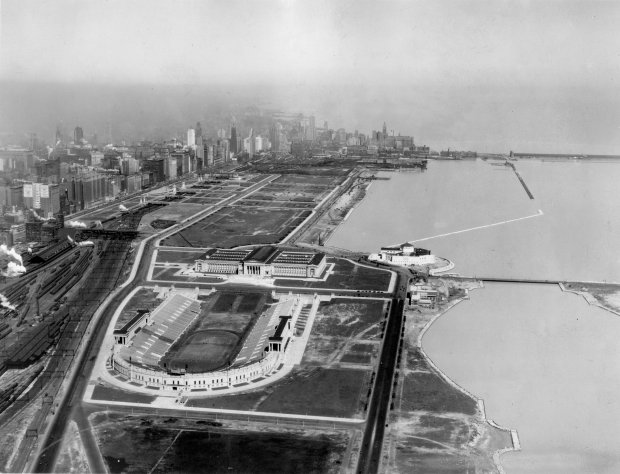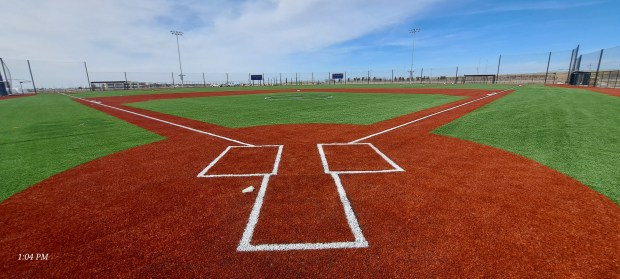The birth of Chicago’s lakefront stadium was marked by a nasty squabble over its name. During construction it was prosaically dubbed the “Grant Park Stadium.” The problem arose when it was decided that it ought to commemorate the GIs who served in World War I.
That led to the name marked in big letters on the stadium’s south wall, “Soldier Field” — a grammatically puzzling moniker that has confounded school teachers and others for the last century.
It was inevitable that Col. Robert McCormick would join the fray over naming the stadium. The Tribune’s publisher was a crusader for spelling words like they sound. In his newspaper, for example, it was “thru” not “through.” In this case, though, he was making an argument that seemed to follow traditional grammar rules.
He threw down the gauntlet in a story under the headline, “This Is Going To Be Soldiers’ Field If It Takes the 1st Division,” a reference to the unit he served in during World War I, of which he was intensely proud.
“Try saying Soldier Field,” the editorial suggested. “Then ask what soldier. Maybe Mike, or it might have been Jan or possibly Sven. ”
Initially deployed against using the stadium as a memorial to soldiers were the Gold Star Mothers, whose sons had died in the war. The “noisy athletic strife,” said its head, Josephine Bentley, would not be a fitting background “for a memorial.” The organization wanted to build a $3 million memorial on Grant Park land she had somehow obtained the deed to.
With the naming issue still up in the air, construction on the stadium got underway, delayed briefly by a strike called by the Industrial Workers of the World, a radical union popularly known (or cursed) as the Wobblies. Its caisson diggers walked off the job in June 1923.
Despite the dissonance of its origins, the stadium’s completion was marked by thousands of voices singing in unison, with numbers including “The Heavens Declare” and “Beautiful Savior.” The Sept. 10, 1924, prededication ceremony was illuminated by lanterns carried by 3,000 children. It wasn’t until a little more than a year later that it was officially named Soldier Field.
The idea of a lakefront stadium had been hatched years earlier. Mayor William Hale Thompson, known as Big Bill, spoke favorably about a municipal stadium. He did so about any project that would detract attention to his sticky fingers in the public till. Big Bill’s first term began in 1915.
The Tribune’s archives contain photographs and clippings of track and field competitions and children performing gymnastics in 1913, possibly in a temporary setup the captions describe as “Grant Park Stadium.”
By 1919, when construction funds were allocated, the low-lying site was covered by 15 feet of water.
“The first act consisted of plunging right out into navigable waters, where gulls and white caps had their own way, and reclaiming the land upon which the stadium now stands,” recalled Linn White, the project’s chief engineer. The site was filled with 25,000 cubic yards of gravel and cinders. Pilings were driven into bedrock for the stadium to sit on.
The stadium resulted from a design competition that specified the structure had to be no less than 100 feet long and no wider than the Field Museum just to the north.
That finished product was an oval stadium so large that a football game was played far from the seats along the sidelines. Fans sitting behind the goal posts might have to read the following day’s newspaper to understand what happened in the game they witnessed.
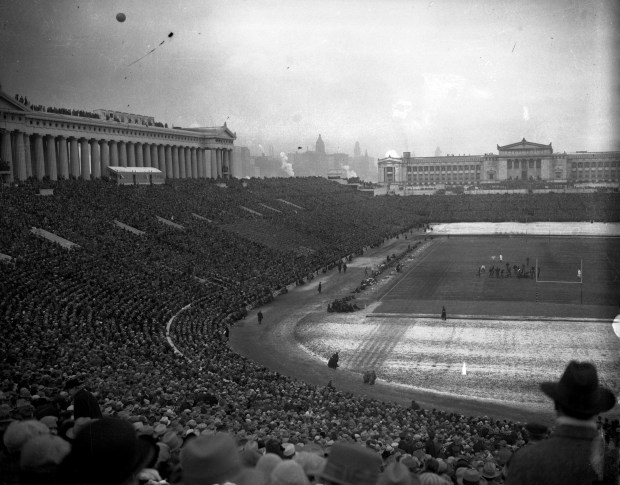
The stadium would be part of a cluster of neoclassical structures emerging on the lakefront site, with the Field Museum and Shedd Aquarium just to the north.
Thompson envisioned a stadium seating 150,000 and larger than anything “the Romans ever built.”
Chicago scaled back from that idea but retained Thompson’s architectural preference. European architects were inspired by America’s modernist architecture. But in America, Doric columns and Ionic pediments were still considered a class act.
In ancient Greece, plays and religious ceremonies were staged in open-air theaters. Paying homage, the north end of Soldier Field was left open by William Holabird and Martin Roche, the Chicago architects who won the design competition. Temporary stands could be set up there for additional seating.
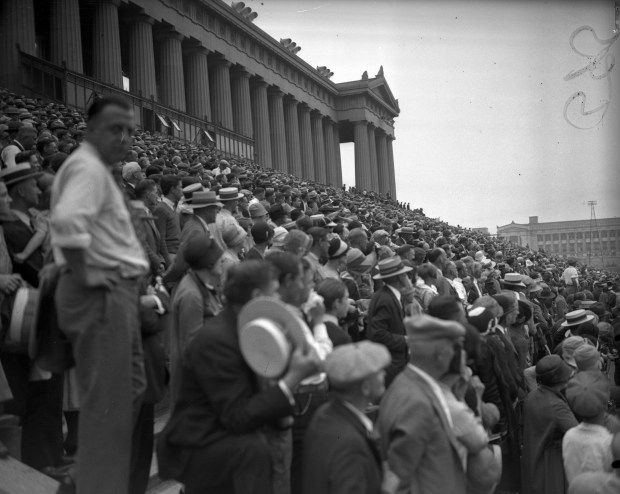
On both sides, the seating sections were topped off by colonnades. Chicagoans were so wowed that Soldier Field was dedicated four times in the first five weeks. Twice more in the next year.
On Sept. 5, 1924, Sgt. John Walsh of the Chicago Police Department won the first athletic contest at the new stadium by throwing a 16-pound hammer 132 feet, 10 inches. On the next day, the official opening, 1,200 police officers paraded into the arena. There were fireworks, two police bands played, and 40 clowns cavorted.
“It’s a lesson to foreigners and those socialistically inclined showing that Americans still have the old pleasures and love of beauty, that they haven’t lost all those qualities in the modern rush of life,” Edward Kelly, a parks commissioner, told the Chicago Daily News. Kelly later became mayor of Chicago and a co-founder of the famed Chicago machine.
Notwithstanding the sometimes poor sight lines, beginning in 1927, an annual game between the Chicago public school football champion against the Catholic school champs drew enormous crowds to Soldier Field. Fifty thousand fans saw Mount Carmel defeat Schurz 6-0.

In 1937, the Prep Bowl drew an estimated 125,000 — in a stadium with only about 76,000 seats. “I couldn’t imagine this many people coming to a high school football game,” recalled Bill DeCoorevont, the star of Austin High School’s team, which drubbed Leo Catholic High 26-0.
The city’s largest events would be held at the stadium, well before it became known as the home of the Bears.
It held the first International Eucharistic Congress in the United States, drawing Catholics from across the globe to the lakefront in 1926. It was the main stage during the Century of Progress World’s Fair in 1933. It held rodeos, car races, ski-jumping contests and more. And it was the home of the Chicagoland Music Festival, where performers such as Bob Hope and Frankie Avalon wowed large crowds with song and dance, for over 30 years starting in 1930.
The success of Soldier Field’s multiple dedications made pageants a perennial Soldier Field offering. The last pageant at the stadium, in 1966, was a commemoration of 1,000 years of Christianity in Poland. In Poland, a Communist government sabotaged the commemoration by scheduling road repairs for the week it was celebrated.
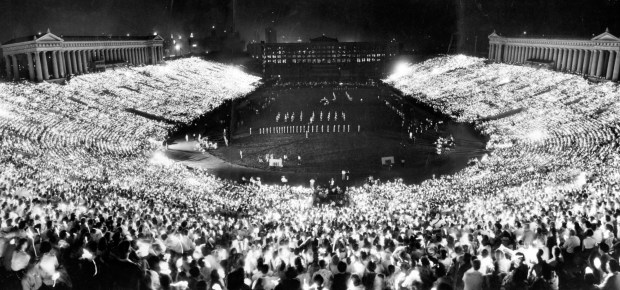
In Chicago, people began arriving at Soldier Field at 11 a.m. By 5 p.m., the stadium was nearly filled. An hour later, 90,000 people saw a parade of people in traditional Polish costumes. A 50-member orchestra played, a 1,200-member chorus sang, and 125 dancers did the mazurka and other Polish dance steps.
Mayor Richard J. Daley and Gov. Otto Kerner spoke, predicting Poland would one day again be free.
That same year, on what would become known as Freedom Sunday, civil rights leader the Rev. Martin Luther King Jr. told nearly 30,000 people gathered at Soldier Field, “This day we must declare our own Emancipation Proclamation,” In 1968, the stadium would be the birthplace of the Special Olympics.
But by the end of the 1960s, the large stadium on the lakefront was hosting fewer city events and games. Salvation would come soon after a well-known football team grew too big for its space at Wrigley Field. In 1971, the Bears started what they thought would be a short run at Soldier Field. No one could have imagined the half-century-long partnership that would follow, including an overhaul that was described as a spaceship landing on top of Soldier Field’s classical columns.
Have an idea for Vintage Chicago Tribune? Share it with Ron Grossman and Marianne Mather at rgrossman@chicagotribune.com and mmather@chicagotribune.com.


